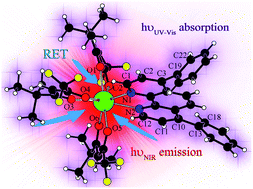Three novel ternary Er3+ complexes emitting in the C band transmission window for fiber optic communications have been synthesised and their structures have been elucidated by single crystal X-ray diffraction. The fluorinated β-diketonate ligand, 1,1,1-trifluoro-5,5-dimethyl-2,4-hexanedione, combines a good absorption cross-section in the ultraviolet region with reduction of non-radiative quenching of the Er3+ emission, while the rigidity and bulkiness of the three different N,N-donors (2,2′-bipyridine, bathophenanthroline and 5-nitro-1,10-phenanthroline) have a pronounced impact on the emission intensity of luminescence. Furthermore, the choice of the ancillary ligand also determines the efficiency of the antenna effect, leading to complete quenching of the ligand-associated visible emission for the optimized complex with 5-nitro-1,10-phenanthroline. Solution processed 1.54 μm organic light-emitting diodes have been manufactured and characterized for this complex, confirming the aforementioned complete resonant energy transfer from the ligands to the Er3+ ion. The features of the reported device fabrication show a simple way to obtain large area NIR-OLEDs.

You have access to this article
 Please wait while we load your content...
Something went wrong. Try again?
Please wait while we load your content...
Something went wrong. Try again?


 Please wait while we load your content...
Please wait while we load your content...